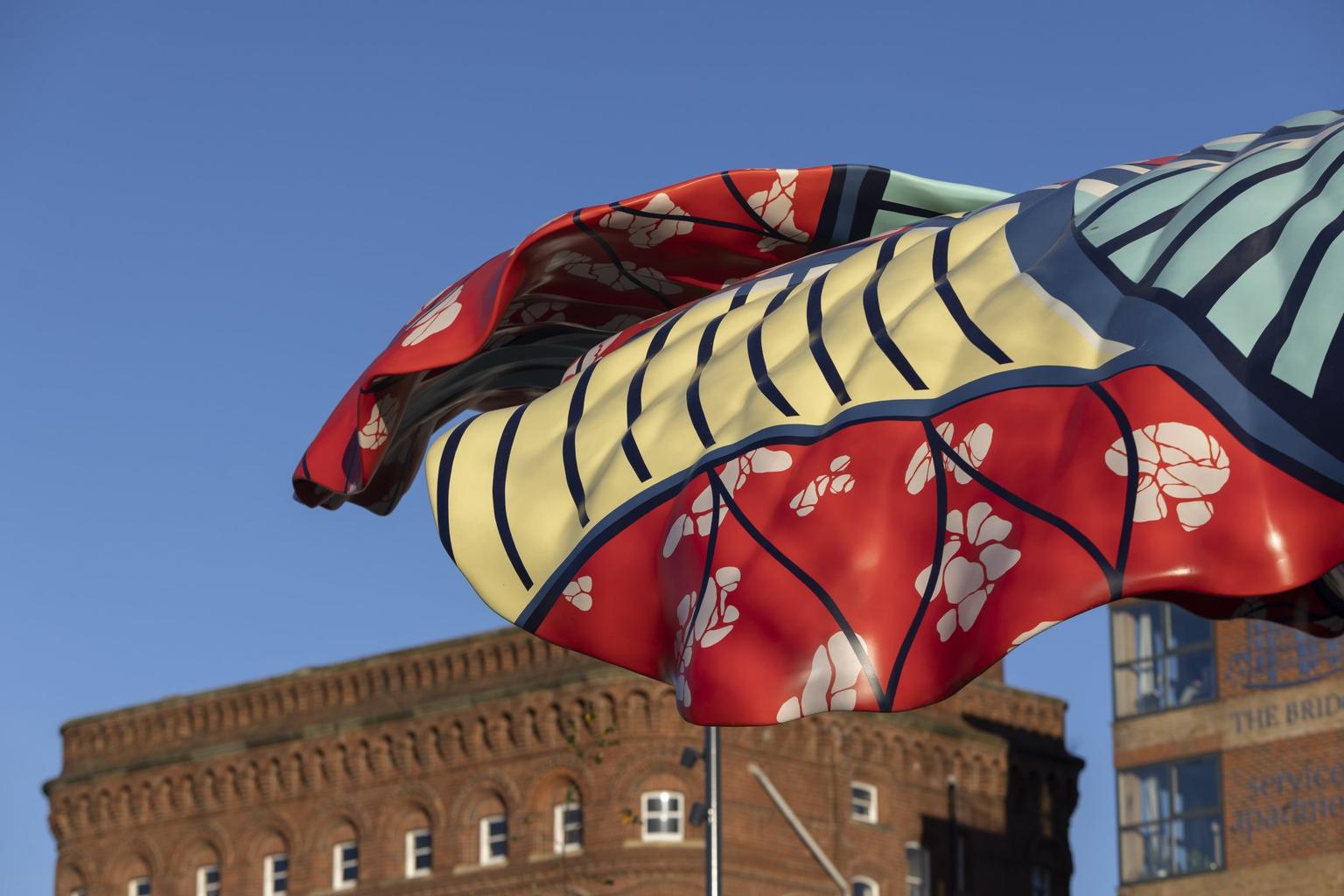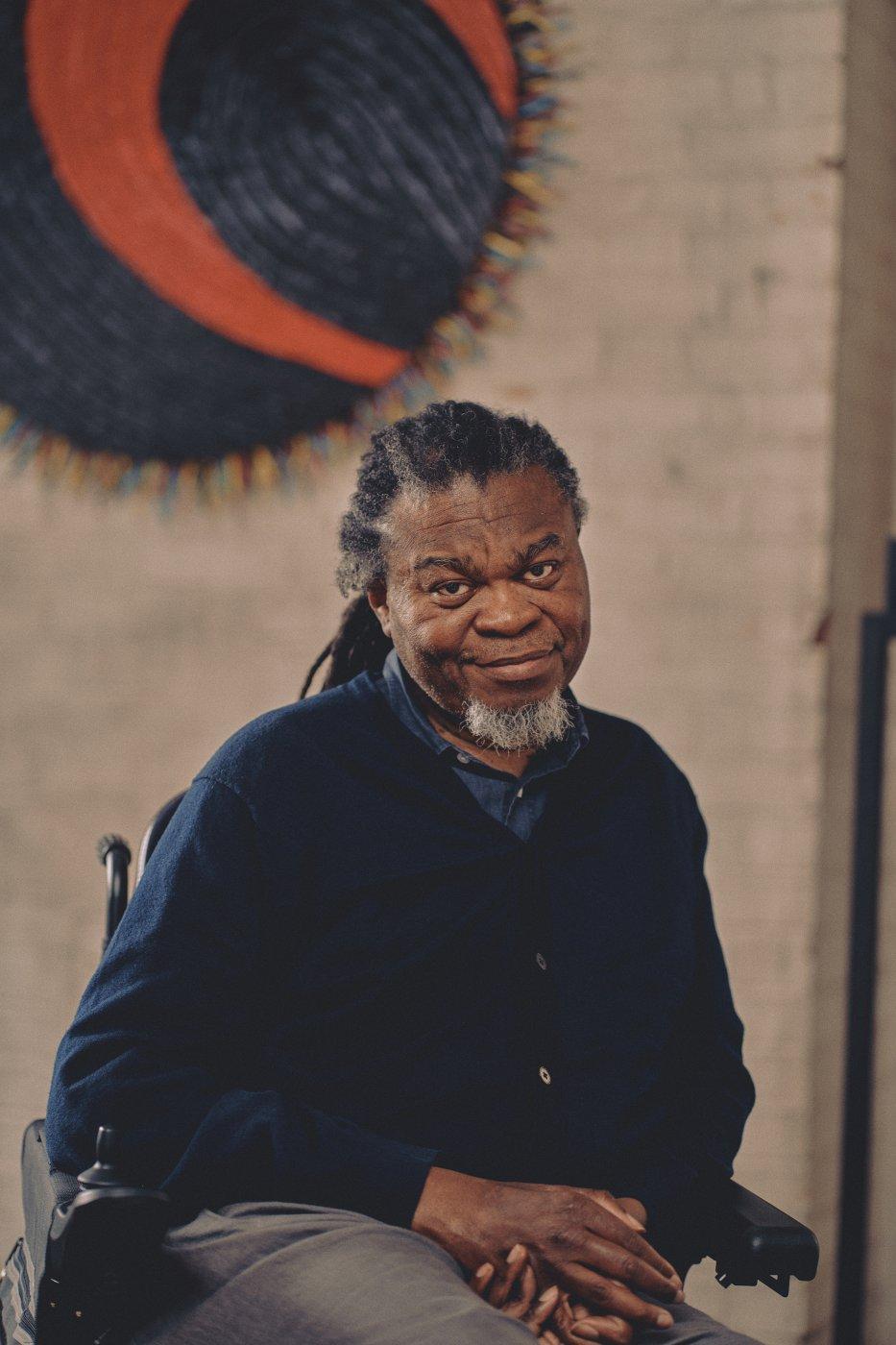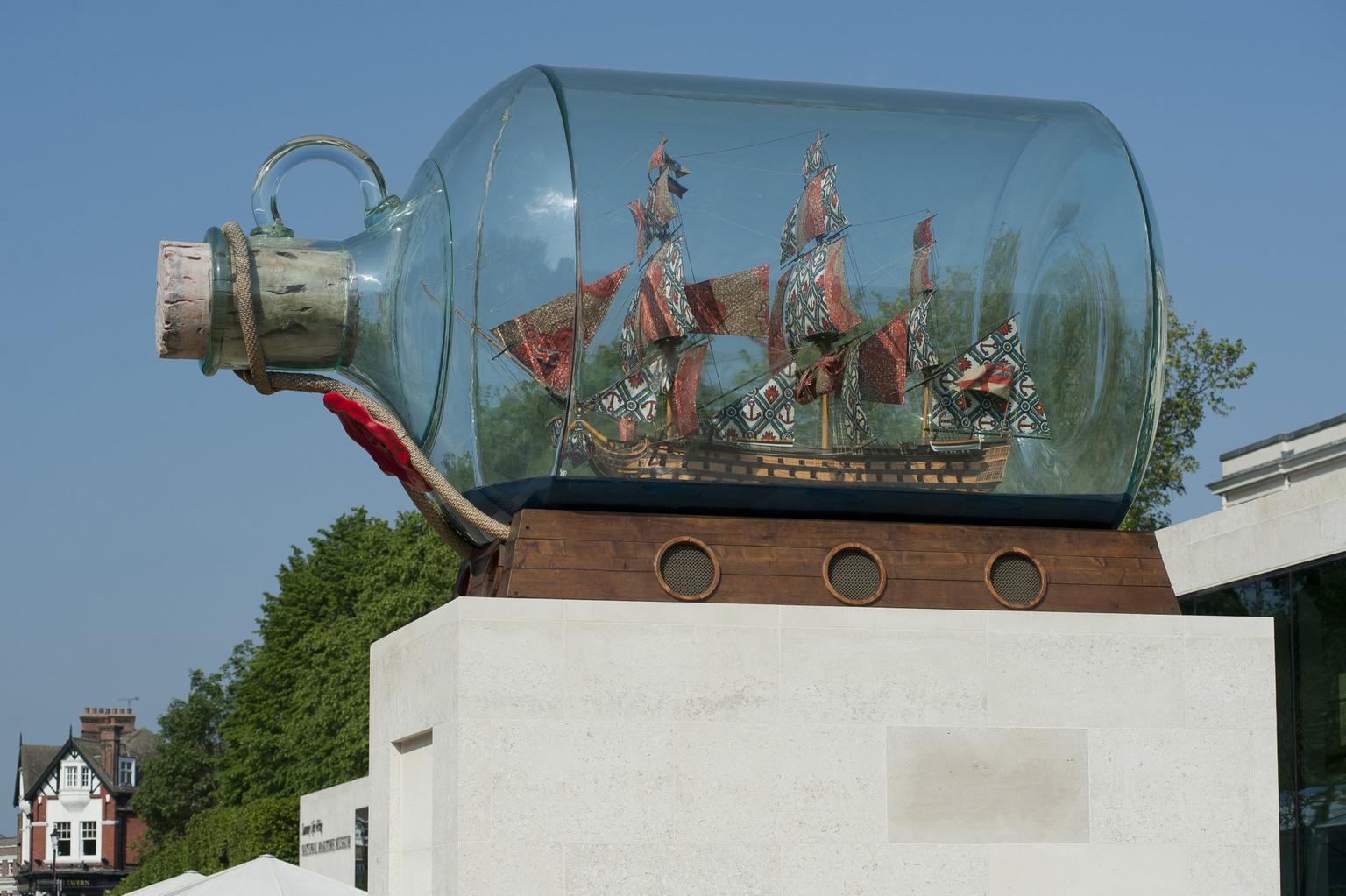Yinka Shonibare on turning difficult histories into inclusive art

On the unveiling of a new public sculpture in Leeds, the artist speaks to the editor of Art Quarterly about art, agriculture, honours and cultural exchange.
A version of this article first appeared in the winter 2023 issue of Art Quarterly, the magazine of Art Fund.
Who is Yinka Shonibare CBE RA?
Born in London in 1962, Yinka Shonibare CBE RA spent his childhood in Nigeria, before returning to London to study at Byam Shaw School of Art and Goldsmiths, University of London. He is acclaimed for his work across media, including sculpture, sculptural tableaux and film, which explores cultural and historical relationships between Africa and Europe. The history behind the signature wax print fabric in which Shonibare dresses his sculptural figures is used as a metaphor for these complex colonial and post-colonial relations. It is inspired by Indonesian batik, mass-produced by the Dutch and imported to Africa.
In 2019 the artist established the Yinka Shonibare Foundation, which supports international cultural exchange through residences and education, and in 2022 launched the Guest Artists Space (G.A.S.) Foundation. This ambitious initiative, which is set across two locations in Nigeria – including a working farm – facilitates international skills-sharing across disciplines and combines cultural exchange with sustainability.
Shonibare’s works are held in collections worldwide, including several acquired for UK public collections with Art Fund support, among them the sculptural works The British Library (2014), acquired for Tate, Nelson’s Ship in a Bottle (2010), acquired for National Maritime Museum, London, and End of Empire (2016), jointly acquired by Bristol Museum & Art Gallery and Wolverhampton Art Gallery. Shonibare will have a solo show at London’s Serpentine Gallery in spring 2024.

HS: How has your use of the wax print fabrics developed in your work?
YS: I’ve been working with them for many years now. If I’m using a batik pattern on a work, like Hibiscus Rising, then I’ll design it myself, but if I’m making a figure with clothing, I’ll buy the fabric from the market. Designs I make might reference the concept of a work, or be based on motifs that regularly occur in those fabrics.
HS: Over the past decade you have made a series of steel and fibreglass resin Wind Sculptures, in which the flowing fabric has become the form of the sculpture itself. Where did that idea come from?
YS: That work evolved out of the sails in the sculpture Nelson’s Ship in a Bottle [a scaled-down replica of Nelson’s flagship HMS Victory, in a glass bottle, with sails made from wax print fabric], originally made for the Fourth Plinth in Trafalgar Square. The sails in that work are about travel and migration, and the wind is very much part of that whole journey. The Wind Sculptures are also asking questions about what sculpture can be: is it possible to sculpt the invisible? Can you capture wind in sculpture? It’s also about making something that’s essentially heavy feel very light.
HS: Many of those works have been created for public spaces, in the UK and internationally. Is having your sculpture in the public realm important to you?
YS: It’s incredibly important because it makes the work very accessible. If you can’t go, don’t have time to go, or can’t even afford to go into a gallery – this is art that meets you on the street. Politically, public sculpture is very important because people can also experience art without having to go into what might be viewed as elitist spaces.

HS: What did it mean to you to be elected a Royal Academician and to be honoured with an MBE and then a CBE – you make a point of using the letters after your name?
YS: What I think is very important is that people who’ve been kept on the margins historically are seen and are noticed, that they take up space and don’t apologise for themselves. When I was awarded my MBE, for example, some people said to me that I shouldn’t accept it. Of course, I’m in no way naïve about the honours system and the history of empire and colonisation, but often it’s your peers who nominate you for these awards, so alongside accepting being an acknowledgement to them, accepting the honour and using the letters is about feeling that I have the right to take that space. Visibility is very important.
HS: The annual Royal Academy Summer Exhibition that you organised in 2021, under the title ‘Reclaiming Magic’, was broadly acknowledged as one of the most diverse and also exciting Summer Exhibitions ever. Was that your intention?
YS: One of the best things about the Summer Show is the access, in that it gives the public an opportunity to show alongside some fantastic Royal Academicians. There are amazing artists at the Royal Academy, many of them fantastic mavericks as well, but I felt that it wasn’t really reflecting the multicultural and accommodating society that now exists, where everyone has a voice. So, as well as the submitted work I invited a wide range of people, including an 80-year-old woman who lives in rural France who makes amazing stitched works – in centuries past, the RA had banned any kind of stitching – and many so-called ‘self-taught’ artists, including African American Bill Traylor (1853-1949). I decided that art is art, and if it’s good, why can’t it be in the show. I think it kind of worked.
HS: How did your initiative Guest Projects, which you set up in East London in 2006, and now works digitally, come about?
YS: The idea was to give artists access to a space in which they could experiment and fail. I put a box outside my studio where artists, curators, performers could drop in proposals, and they could have the space for a month. The art market was getting very strong and it was difficult for many artists coming up to find spaces to show their work, particularly in London. When I was coming up as an artist in the late 1980s and early 1990s the economy was down, property was cheap and London had lots of project spaces. The example is always given of Damien Hirst’s ‘Freeze’ exhibition but at that time we were all taking over warehouse spaces and doing it. When I acquired my studio, I was aware that the generation after me couldn’t do that. I think that all arts are connected, which is why I wanted to support multidisciplinary experimental production. We had talks, screenings, even a supper club called the Artist Dining Room, where a chef would cook based on the culture of an artist, for example Mexican food for Frida Kahlo. It was very interesting.
HS: How did Guest Artists Space (G.A.S.), your foundation in Nigeria, then come about?
YS: Most forms of discrimination are based on ignorance of other people and not quite understanding them, which led me to want to facilitate cultural exchange. I thought, ‘There are many people who have never had the opportunity to go to Africa, but I could provide that opportunity, and as part of that, local creatives and artists can exchange ideas with guests from different parts of the world.’ I’ve been working on it for about 10 years, with a lot of that time spent dealing with all the bureaucracy and the planning permission needed for all the various things involved.
HS: What was the idea behind incorporating a working farm (located about two hours from Lagos) as part of the initiative?
YS: The idea of adding agriculture and food sourcing relates partly to the fact that Nigeria imports a lot of its food. I wanted to create something that wasn’t just about a holiday experience but could also contribute in a very small way to supporting a local economy. We’re not going to change the world, but it’s an important matter of principle. The farm was abandoned and completely overgrown when we bought it, so we built the farm houses and a house for the artists and put the polytunnels in. Lack of road infrastructure is a big issue in Nigeria because it results in food being spoiled before it gets to market, so building a road is one of the first things we did. We now have a number of crops growing there, including tomatoes, peppers, plantains, turmeric and ginger.
HS: How involved do visiting artists get in the farm?
YS: It’s entirely up to them, but we’ve collaborated with University of the Arts London and its Art for the Environment Residency Programme, and a couple of their alumni have come and worked on projects there. And then there’s the building in Lagos, where we have a small multipurpose gallery/studio, three bedrooms for artists and a performance space at the front. We’ve had a lot of residents, including curators from Germany and people from the Stockholm School of Economics, as well as artists. I like to have different disciplines in the same forum. At the end of your residency, you have to make a public-facing presentation in the gallery and that’s how the residents interact with local people.
HS: Why do you think it’s important to you to not just be making art that speaks to issues of inclusivity, equality and sustainability, but to actually be doing something to address them?
YS: Giving something back is very much part of it. My art is actually quite political, so it’s also the social part of my practice. I can complain about injustices, but I should also be able to contribute something to make the world at least a little bit better.
'Yinka Shonibare CBE RA' at Serpentine South, London, from 12 April to 1 September 2024. 10% off in café with National Art Pass.
End of Empire can be seen at the Box, Plymouth, 12 October 2023 to 23 June 2024, as part of the gallery’s ‘Revisiting History’ season, free to all.
Hibiscus Rising is located at Leeds South Bank. The landscaping of the public space around the sculpture was supported through a campaign run on Art Fund’s crowdfunding platform, Art Happens.